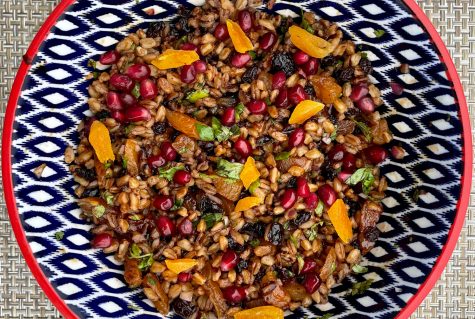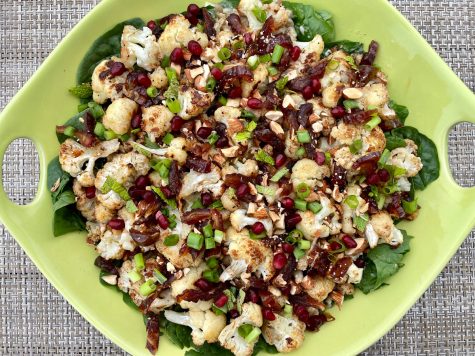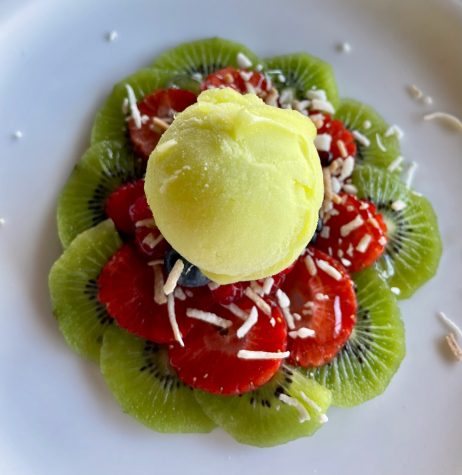Serve up ‘unusual’ fruits this Rosh Hashanah
Published September 12, 2022
Rosh Hashanah, which begins at sundown Sunday, Sept. 25, ushers in the 10 “Days of Awe,” which culminate with Yom Kippur. Rosh Hashanah is a beautiful holiday on its own, rich with symbolism and traditions that celebrate the New Year.
I have wonderful childhood memories of our family gatherings and traditions for Rosh Hashanah. My sister Bobbie and I would get new dresses to wear to services, and our dinner table would be set with our finest embroidered tablecloth, china, crystal and specially polished silver serving dishes. By dinnertime, our house would be filled with family, close friends and the aromas of that holiday meal.
My mother made every part of that feast from scratch: raisin challah, Polish-style sweet gefilte fish, chicken soup with tender-filled kreplach, honey-glazed carrots, sauteed green beans, sweet-and-sour cabbage rolls, roast chicken, a colorful fruit-filled Jell-O mold, a munificent apple torte, and to-die-for chocolate-walnut rugelach. Before enjoying this special feast, we lit candles, chanted the kiddush, said the hamotzi over the challah, and dipped apple slices in honey, just as many of us still do.
But, as I recently learned, on the second night of Rosh Hashanah fruit has an added significance. I had always known that fruit played an important role in the Rosh Hashanah meal. Those apples that we dip in honey and the sweet apple cake are symbolic of our hope for a sweet year ahead. And though certainly not as prevalent in Ashkenazi cuisine as in Sephardic cuisine, many holiday dishes contain other fruit, as well. Examples include carrot tzimmes, fruit-infused gravy for brisket, that iconic “Silver Palate” Chicken Marbela (a popularized Jewish American holiday dish), green salad tossed with fresh or dried fruits, and a variety of rice and other grain dishes that are cooked or garnished with dried fruits.
There is, however, another tradition reserved for the second night of Rosh Hashanah: following the kiddush on that night, we are supposed to sample an “unusual” fruit. To qualify as “unusual,” the fruit should be one you have never had before (or at least not eaten during the past year).
According to the rabbis, this tradition comes from the fact that Rosh Hashanah, unlike Hanukkah, Sukkot, Passover and the other Jewish holidays, is the only holiday where we recite the Shehecheyanu blessing on not just the first night but also on the second night. The translation of that blessing is: “Blessed are You Eternal Spirit who has given us life, sustained us, and allowed us to arrive in this moment.” It celebrates a new first experience, and by reciting it, we express gratitude for being present to experience that newness. And the way we experience it on the second night is by sampling a new or “unusual” fruit.
Jamie Geller, the bestselling cookbook author and chief media and marketing officer at Aish HaTorah, has a lovely interpretation of this tradition: “The very fact that we’ve sought out something new represents our deep-down desire to reinvent ourselves, to make ourselves better people in the coming year. Look at how Judaism elevates a squishy bite [of a new fruit] to a token of commitment!”
But these days, finding an unusual fruit is a challenging assignment indeed. Kiwis, mangoes and papayas would have been considered “unusual” when I was a kid, but today they are standard items in the produce section of your supermarket. So where to find those illusive “unusual” fruits?
Consider visiting one of these exciting grocery stores to find your special holiday fruit:
• Jay International Food on Grand Ave. (for dragon fruit, and guava, and others)
• Global Foods Market in Kirkwood (for yellow, red, and white dragon fruit, yellow dates, sapote fruit, mangosteen, and rambutan)
• United Provisions on Delmar in the U.City Loop (for Asian pears, lychee, dragon fruit, and others)
• Worldwide International Food Market in Hazelwood (for yellow dates and cactus fruit)
Following with the fruit theme of this column, here are a few fruit-centric recipes for dishes to accompany your family’s traditional roasted chicken, brisket, or fish, and one to finish off your meal in style. If your festive meal this year will be vegetarian, both of the side dishes, along with a green salad, would make for a delicious and nutritious holiday meal.
Shanah Tovah!
Jeweled Farro Pilaf
(Recipe adapted from Flavors of the Sun by Christine Sahadi Whelan)
Don’t even think about skipping the first step of this recipe. The toasted farro is what sets this dish apart from all other grain dishes. Do pay attention, however, when toasting the farro. It can go from perfectly toasted to burned in a matter of seconds!
Ingredients:
3 tbsp. extra virgin olive oil, divided
1 c. pearled farro
(bulk or grain aisle section Whole Foods)
2 ½ c. vegetable broth or water
1 tsp. fine sea salt
¼ tsp. ground white pepper
1/8 tsp. cayenne pepper (optional)
½ c. dried apricots, cut into thin strips
½ c. golden raisins
1/3 c. finely minced red onion
½ c. chopped fresh cilantro
3 tbsp. pomegranate molasses
(available at Whole Foods and most ethnic grocery’s)
2-4 tbsp. fresh pomegranate arils (seeds)
DIRECTIONS:
1. Heat 1 tbsp. olive oil in a medium saucepan over medium heat. Add farro and toast, stirring frequently, until aromatic and golden brown. Add salt, white pepper, and cayenne (if using) and stir. Add broth or water, stir, and bring mixture to a boil. Cover saucepan and simmer for 25-35 minutes, or until farro is just getting tender (avoid letting it get mushy). If farro is tender before all the liquid has been absorbed, drain excess liquid by putting the farro in a colander.
2. Transfer farro to a large bowl and add apricot strips, golden raisins, minced red onion, and cilantro; gently mix until everything is evenly combined. Drizzle pomegranate molasses and remaining 2 tbsp. olive oil over mixture. Gently fold into grain mixture. Before serving, garnish pilaf with pomegranate arils. (Pilaf can be enjoyed warm or at room temperature. It’s even good cold on day #2!)
Makes 6-8 side servings.
Roasted Cauliflower with Lentils, Dates, and Pomegranate Arils
(Recipe adapted from Flavors of the Sun by Christine Sahadi Whelan)
Ingredients:
1 medium head of cauliflower, stem and greens discarded, and cauliflower broken into florets
½ tsp. ground cumin
¼ tsp. ground cinnamon
¼ tsp. ground ginger
Pinch of cayenne pepper
¼ c. + 1 tbsp. extra virgin olive oil
3/4 tsp. coarse kosher salt, divided
1 tsp. freshly ground black pepper, divided
½ c. dried brown lentils
3 tbsp. freshly squeezed lemon juice
2 tbsp. tahini (sesame seed paste)
1 tsp. honey
½ bunch scallions, cut into slices and separated by color
2 ½ c. loosely packed spinach or arugula
5 dates, pitted and chopped
½ c. roasted unsalted almonds, coarsely chopped
Handful of fresh mint, torn, for garnishing
2 tbsp. pomegranate arils, for garnishing
DIRECTIONS:
1. Preheat oven to 425 degrees. Line a large, rimmed baking sheet with parchment paper; set aside.
2. Rinse and pat cauliflower dry; reserve.
3. In a large mixing bowl, stir together cumin, cinnamon, ginger, and cayenne pepper. Add ¼ c. olive oil and stir to combine. Add reserved cauliflower and toss to evenly coat with spice mixture. Turn cauliflower out onto prepared pan and sprinkle evenly with a ½ tsp. each of salt and pepper. Roast cauliflower in preheated oven until it is just tender and golden brown, about 30 minutes.
4. While cauliflower is roasting, add lentils to 2 c. of lightly salted boiling water. Stir, cover pot, and reduce heat to a simmer. Simmer lentils for 15-20 minutes, or until tender but not mushy. Drain any excess water from lentils and reserve.
5. Whisk together lemon juice, tahini, honey, and 1 tbsp. olive oil in a large bowl. Add 2 tbsp. of water and whisk mixture until it is smooth.
6. Add the lentils to the tahini mixture, along with the white parts of the scallions, and ¼ tsp. of each salt (taste before adding) and black pepper. Mix gently to combine.
7. Arrange spinach or arugula on a large serving platter. Evenly top with lentil mixture, followed by the roasted cauliflower. Garnish with dates, almonds, green scallion slices, fresh mint, and pomegranate arils… in this order.
Makes 6-8 side servings.
Regal Fresh Fruit and Sorbet Dessert
This is a simple, elegant, delicious, and healthy way to complete your holiday feast. For this composed dessert, you will need 1 of each for every serving: kiwi, red plum, and scoop of lime sorbet. The fruit can be sliced and even arranged on individual dessert plates in advance; keep refrigerated until you’re ready to top the fruit with a scoop of sorbet, garnish with coconut, and serve. Feel free to substitute other fresh, vividly colored fruits and your favorite sorbet flavor!
Ingredients:
Kiwi fruits
Red-fleshed plums
Lime sorbet
Sweetened shredded coconut, for garnishing
DIRECTIONS:
1. Peel and slice 1 kiwi per serving. Arrange slices in a circle on the outer rim of a small dessert plate.
2. Cut 1 plum per serving in half, remove the seed and slice. Arrange the slices in a circle inside of the kiwi slices.
3. Top each plate of fruit with a scoop of sorbet and sprinkle with shredded coconut.
Makes as many servings as needed.


















